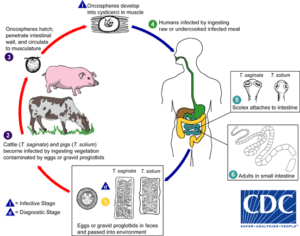Contents:
Medical Video: Pork Tapeworm Parasitic Infestation
Tapeworm disease is an infection caused by the taenia parasitic worm. Therefore, tapeworm infection is also called taeniasis. Symptoms include diarrhea, abdominal pain, decreased appetite, drastic weight loss, anal pain, fatigue, and insomnia. However in many cases, taeniasis sufferers can not feel any symptoms.
There are two main types of parasites that cause tapeworm infections: Taenia Saginata which comes from cattle and Taenia solium which comes from pigs. Tapeworm life cycle T. saginata and T. solium very similar. This is the life cycle of tapeworms.
Life cycle of tapeworms, parasites that cause taeniasis
The life cycle of the taenia tapeworm will begin once humans swallow eggs or tapeworm larvae. After swallowing, the egg will develop into larvae in the digestive tract. Below is a full explanation.

1. Eggs of loose worms into the environment
Tapeworms are parasitic animals. Therefore, these animals need the host's body to breed, and the human small intestine is the only host for it T. saginata and T. solium to survive.
Adult tapeworms multiply by laying eggs. Mature worm eggs develop into oncospheres larvae which still contain eggs, then are released from the body of the adult tapeworm and out of the anus with human faeces.
2. Livestock infections
When tapeworm eggs come out of the human body, it is possible that these worm eggs can move to another host. Pigs and cows are two types of animals that often host tapeworms. Cows and pigs are infected with tapeworms by consuming livestock food contaminated with worm eggs.
In animal intestines, oncospheres larvae hatch into worm embryos, then attack the intestinal wall and enter the circulatory system in these animals. The larvae then spread to other parts of the animal's body, such as the tongue muscles, heart, liver, lymphatic system, and shoulders. Tapeworm embryos can last for several years in these animals.
3. Human infection
Humans can swallow tapeworm larvae hidden in raw or undercooked animal flesh. You can also swallow tapeworms from eating food or drinks contaminated with human or animal feces that contain tapeworms.
After swallowing, the scolex (head) of the tapeworm will stick firmly to the wall of the small intestine and grow into an adult tapeworm that spills eggs in infected human waste. Adult tapeworms can extend up to 15 meters and can survive up to 30 years in the human body.
After the new eggs migrate to the anus and enter the stool, then the life cycle of the tapeworm will repeat again.
How to prevent tapeworm infection?
One way to prevent tapeworm infection (taeniasis) is to cook the meat until it is fully cooked at a safe temperature. If possible, a food thermometer should be used to measure the temperature in cooked meat. Don't taste the meat until it's cooked.
The United States Department of Agriculture (USDA) recommends the following points as a way of processing the right meat:
- For whole pieces of meat (not including poultry meat): Cook until at least 63 ° C is measured with the food thermometer in the thickest part of the meat. Then leave the meat briefly for three minutes before consumption.
- For minced meat (not including poultry meat): Cook until at least the meat has a temperature of 71 ° C. Minced meat does not require rest periods before consumption.
For three minutes of rest after the meat has been removed from the source of the fire, the temperature will remain constant or continue to increase, which can destroy harmful pathogens.
Also make sure to pay attention to how to store the right meat. Place the beef in the refrigerator at 1 ° Celsius or in the freezer at -18 ° C immediately after buying it. It aims to keep the meat fresh, maintain its nutrition, and extend the shelf life of food. If stored in a refrigerator, raw beef / pork should only be stored for one or two days. While cooked beef can last for three to four days.
Another way is to always maintain personal hygiene, by always washing hands before and after eating and after and before processing meat. Keep meat cooked separately from raw meat, raw food, and frozen food in general.












